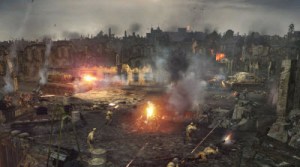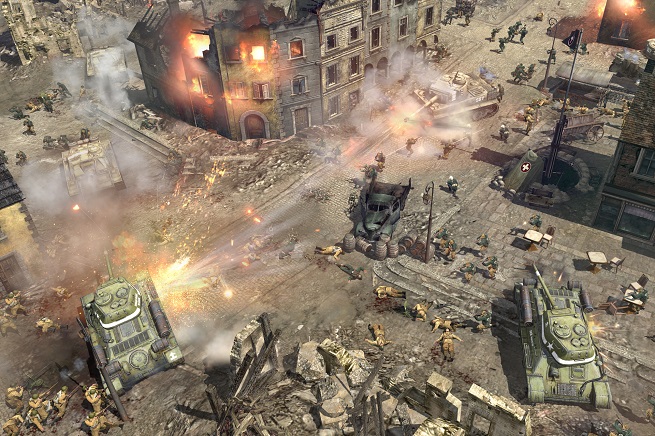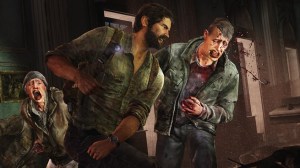The public’s appetite for zombie games amazes me. I’ve enjoyed playing these games, too, dispatching the terrifying zombie hordes as they close in on me from all directions. But in memory of other fads that peaked and came crashing down to earth, I wonder if zombies will run their course in video games. Having just played Company of Heroes 2 from Sega, I also wonder if zombie games will go the way of the oversaturated World War II game market — and hope that games based on the Second World War will make a comeback.
Company of Heroes 2 reminded me what it’s like to play a game filled with strategic thinking, pitched battles, and a combined arms approach to tactical combat. It was a refreshing dip back into the underrepresented spaces of historical combat and real-time strategy. These categories have died out with the push to make games more immediately relevant to today’s young gamers who have twitch reflexes and feel like the weapons of World War II just don’t let them reflect their inner selves properly.
For a time, World War II titles like Call of Duty, Medal of Honor, Brothers in Arms, Battlefield, Close Combat, Commando, and Wolfenstein were coming out one after another. Those games had the moral high ground, as former id Software executive Todd Hollenshead once put it, because “everybody hates Nazis.” They were the perfect enemies, because they had the best weaponry of the day. Then the saturation point came. Gamers got sick of it. The Nazis didn’t make a comeback in popularity. Rather, time passed the genre by.
Activision realized this when it launched Call of Duty 4: Modern Warfare in 2007. That game made the leap from the Second World War II to modern combat, and it triggered huge growth in the first-person shooter market. The World War II genre fell apart as the titles couldn’t compete, and the arms race to develop high-end modern combat games took off.
I suspect we have had every kind of zombie game imaginable, with even Plants vs. Zombies filling the comic zombie game niche for younger players. In our modern obsession with the undead, we’ve got everything from Dead Rising to the upcoming Dying Light. The types of zombies have evolved over the years, starting with the slow-moving undead in the Night of the Living Dead and the sort-of-undead in Resident Evil, which has had six major titles.
The problem with slow-moving zombies is that the shooting is too easy. It’s like shooting fish in a barrel. That prompted another major innovation in gaming: fast zombies. Titles like Left4Dead, Dead Island, and The Last of Us gave gamers more challenges by speeding up the zombies. Dying Light has an interesting approach where zombies are slow during the day and fast at night.
 The art form has reached highs as well. Dead Island gave us a memorable trailer that could bring tears to your eyes. The Walking Dead gave us an excellent episodic approach to zombie games that delved into the moral choices that survivors had in end-of-the-world apocalypse scenarios. And The Last of Us took the zombie genre to its pinnacle, in my opinion. It has deep characters, an interesting story, and a wide variety of enemies who are infected with a zombie virus.
The art form has reached highs as well. Dead Island gave us a memorable trailer that could bring tears to your eyes. The Walking Dead gave us an excellent episodic approach to zombie games that delved into the moral choices that survivors had in end-of-the-world apocalypse scenarios. And The Last of Us took the zombie genre to its pinnacle, in my opinion. It has deep characters, an interesting story, and a wide variety of enemies who are infected with a zombie virus.
Our Threeview academic critic, Soraya Murray, astutely observed about our obsession with zombie games, “The greater collective fear of contagion; the fear of being overrun, overwhelmed, colonized; and the fear/desire of the extreme survivalist scenario — these are what interest me the most, particularly in a cultural moment when there is so much global restructuring, competition, and change underway. In time, zombies have gotten faster, and so have the changes.”
Sure, some games have tried to combine the best of both by combining zombies and World War II. But I’m looking forward to the next Wolfenstein game, which moves the Nazi revenge fantasy into an alternate universe where the Nazis won the war. Those Nazis are even more difficult to fight, since they have the weapons of the future. And they are even more satisfying to kill. Wargaming’s World of Tanks is a big hit as a massively multiplayer online game, and its World of Warplanes has just gone into open beta.
I suggest that you play Company of Heroes 2 in the meantime. This game is a successor to Company of Heroes, which debuted in 2007 as the high-water mark for the World War II gaming trend. The original title was a frenzy of action that combined real-time tactical combat with a strategic bird’s-eye viewpoint. The new game is set on the Russian front, starting with Hitler’s Operation Barbarossa in 1941 and spanning the length of the war. Our reviewer Rob Savillo astutely pointed out the flaws of the game, like the lack of a great tutorial to teach you how to perform different functions.
I enjoyed the story. It exposes the brutality of the Soviet counter-offensive against the Germans, where retreating Russian soldiers were frequently shot by their commanding officers. You can carry on your surviving troops, role-playing game style, into the next mission. And each battle often turns on the bravery of a single squad, like the anti-tank gunner that sneaks behind a German Tiger tank, or the squad that lobs a grenade into an MG42 machine gun nest, or the sprint through the snow to reach a building before a bone-chilling blizzard sets in. This kind of combat and gameplay might have seemed old hat in 2007, but in 2013, it’s downright refreshing.
VentureBeat's mission is to be a digital town square for technical decision-makers to gain knowledge about transformative enterprise technology and transact. Learn More


